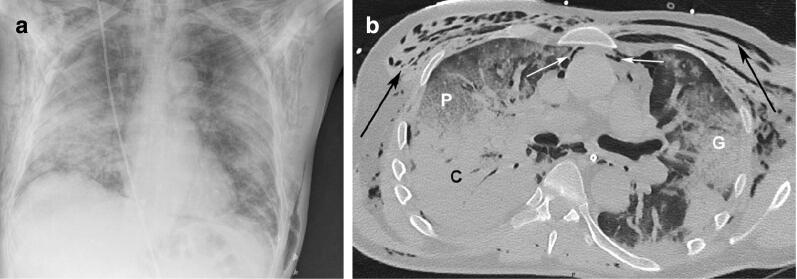A 57-year-old man with no relevant medical history was referred to our institution for severe acute dyspnea, fever and cough, occurring two weeks after onset of moderate breathlessness, diarrhea and anosmia.
Chest X-ray performed upon admission demonstrated diffuse subcutaneous emphysema and bilateral consolidations (Fig. 1, panel a).
Fig. 1.
a. Chest X-ray demonstrating diffuse subcutaneous emphysema and bilateral pulmonary infiltrates. b. High-resolution chest CT showing an association of consolidations (C), ground glass opacities (G) and crazy paving pattern (P) highly suggestive of COVID-19. Pneumomediastinum is well identified (white arrows) as well as subcutaneous emphysema (black arrows)
Two hours after admission, because of an acute respiratory distress syndrome, the patient was intubated for mechanical ventilation.
Chest CT was then performed. It demonstrated pneumomediastinum, subcutaneous emphysema, consolidations, ground glass opacities and crazy paving, typical pattern of SARS-CoV-2 pulmonary infection (Fig. 1, panel b). Specific SARS-CoV-2 polymerase chain reaction (PCR) was negative.
Pneumomediastinum revealing SARS-CoV-2 pulmonary infection is a rare entity. It is probably secondary to diffuse alveolar injury causing alveolar rupture and air leakage. PCR is the method of reference for diagnosis of COVID-19, but false negative rate approaches 30%. It can be negative in particular when performed late after onset of infection as in this case. Chest CT has a high sensitivity to detect SARS-CoV-2 pulmonary infection in the context of pandemic. While pneumomediastinum is a well-known complication of mechanical ventilation, it was present before intubation in this case.
Pneumomediastinum and subcutaneous emphysema must be known as a possible complication of SARS-CoV-2 pulmonary infection.
Compliance with ethical standards
Conflicts of interest
The authors declare that they have no conflict of interest.
Footnotes
Publisher's Note
Springer Nature remains neutral with regard to jurisdictional claims in published maps and institutional affiliations.



